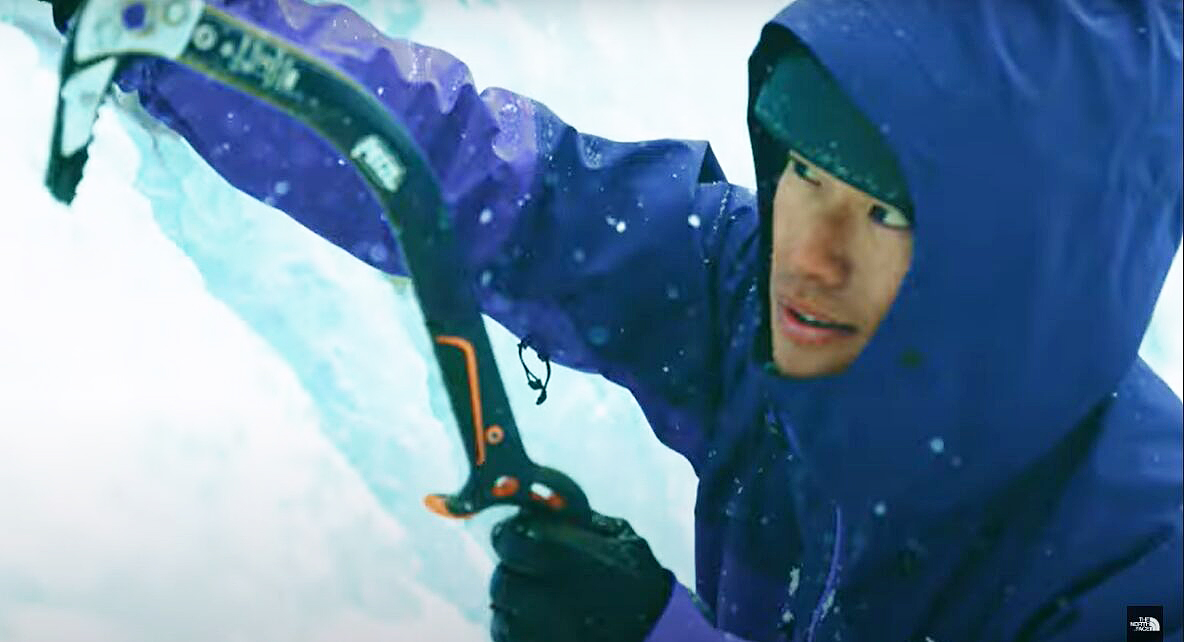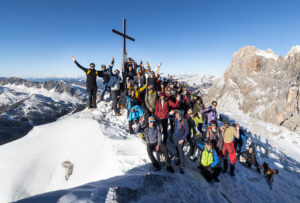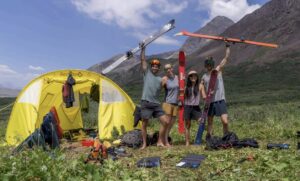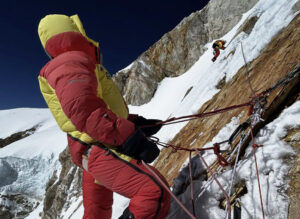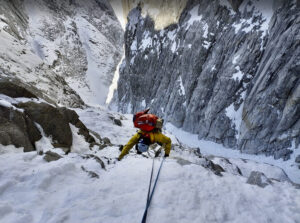Yudai Suzuki belongs to that new generation of Japanese climbers who are pursuing excellence in exploratory alpinism by keeping an old-fashioned sense of adventure and purity.
In the last two years, Suzuki and a small team of friends have achieved two impressive first ascents in the isolated Hindu Raj — Ghamubar Zom 5 and Thui 2. ExplorersWeb ranked both among the best expeditions of 2024. Suzuki has also done highly difficult new routes on Ausangate and Quitaraju in the Andes. He is 30 years old.
We spoke with Suzuki about his intense climbing career, his mountaineering values, and the small but outstanding alpine community in Japan to which he belongs.
From college to the Himalaya
Like most Japanese alpinists, Suzuki started with a university mountain club (Waseda University, in his case). After a quick introduction to the Japanese Alps at the age of 18, he joined a team on Nepal’s Island Peak in 2015.
“Island Peak made me realize I could climb normal routes everywhere in the world,” he said, “so I decided I wanted to attempt peaks that had never been climbed before.”
He was in a hurry to experience the unknown.
“Alpinism has to offer results before turning 30,” he recently told the Shugakuso blog. “I wanted to do some powerful climbs in my 20s.”
Suzuki quickly showed another characteristic of modern Japanese alpinism: ingenuity in finding new goals. In 2017, he climbed Nepal’s very remote Lajo Dada.
“That experience taught me that adventurous climbing is so much more fun and exciting than walking up normal routes,” he said.
Next on his agenda of progression:
“I wanted to try more vertical and technical climbing on unclimbed faces or steep mountains.”
When not on expeditions, he trains hard on rock, both sport and trad.
“These skills are necessary for modern alpine climbing, even on 6,000m peaks,” he says. “I usually climb a lot from mid-October to December after my expeditions. Then, I shift to winter climbing and ski mountaineering. Ski mountaineering and freeriding train strength, endurance, and cardio for alpine climbs on 6,000m and 7,000m peaks.”
Rising star
Suzuki also spent a year climbing around the U.S., Canada, the European Alps, and Patagonia. On a follow-up trip to the U.S., he climbed El Capitan’s Freerider and the impressive Moonflower Buttress on Mt. Hunter (see photo below).
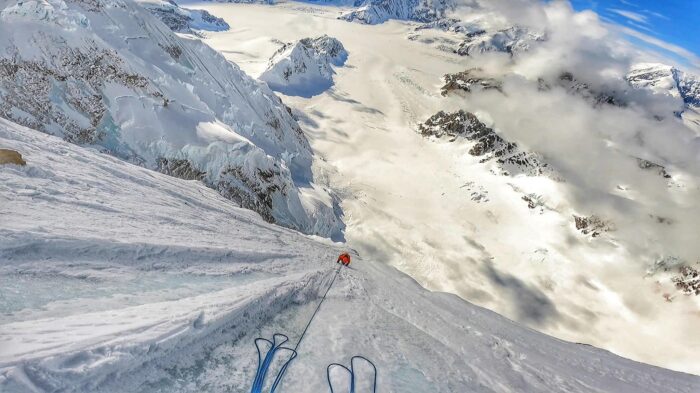
Suzuki on Mt. Hunter, 2022. Photo: Yudai Suzuki
In 2022, he attempted the first ascent of Gasherbrum 6, reaching 6,000m. Yet his career took off in 2023 with the first ascent of the north face of Ausangate (6,381m) in Peru. Called the Japones Direct, the 1,100m route featured difficulties up to 5.10a, WI6 Ⅵ.
He followed this up last year with the first ascent of Ghamubar Zom 5 by its northwest ridge — a dizzying 2,000m M5, 5.9, 70° Ⅵ route.
In 2024, in addition to Thui 2, Suzuki made the first ascent of the south face/south spur of Quitaraju in Peru. Here, Suzuki faced highly exposed sections and survived a 15m fall.
“I may never be able to complete such a difficult and dangerous climb again in my life,” he wrote after returning home.
Suzuki has also done several new routes and many outstanding free-ride lines in the Japanese Alps.
Van life
Like many Japanese climbers, Suzuki used to have a day job (with an internet company) and climb during his holidays, but the COVID pandemic prompted him to quit his job and spend more time on expeditions. Of course, it came with a toll.
“I would say I am a semi-fulltime climber because sometimes I have photographic assignments and write articles or guide backcountry ski trips,” he said. “I also coach at the University’s mountaineering club,” he said.
He admits that he lives “very frugally.”
“Most of the time, I live in my van near the mountains, driving where conditions are good each season.”
Some weeks ago, Suzuki had a setback when another vehicle crashed into his van on an icy road.
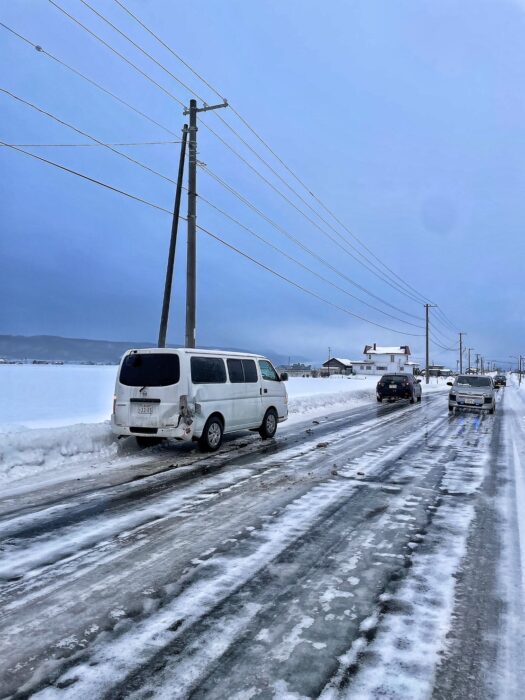
Suzuki’s van was hit on an icy road a month ago. Photo: Yudai Suzuki
The less known, the better
In all his goals, Suzuki stays coherent with the principles of exploratory alpinism.
“I go on expeditions to feel a sense of adventure and to experience the maximum level of self-sufficiency,” he explained. “Summiting is important, but style is essential. I personally feel that a 30% chance to reach the summit is an ideal expedition percentage.”
He recognizes that sometimes summit attempts are not even possible. That, too, is part of alpine expeditions, especially in the Himalaya or rarely visited ranges.
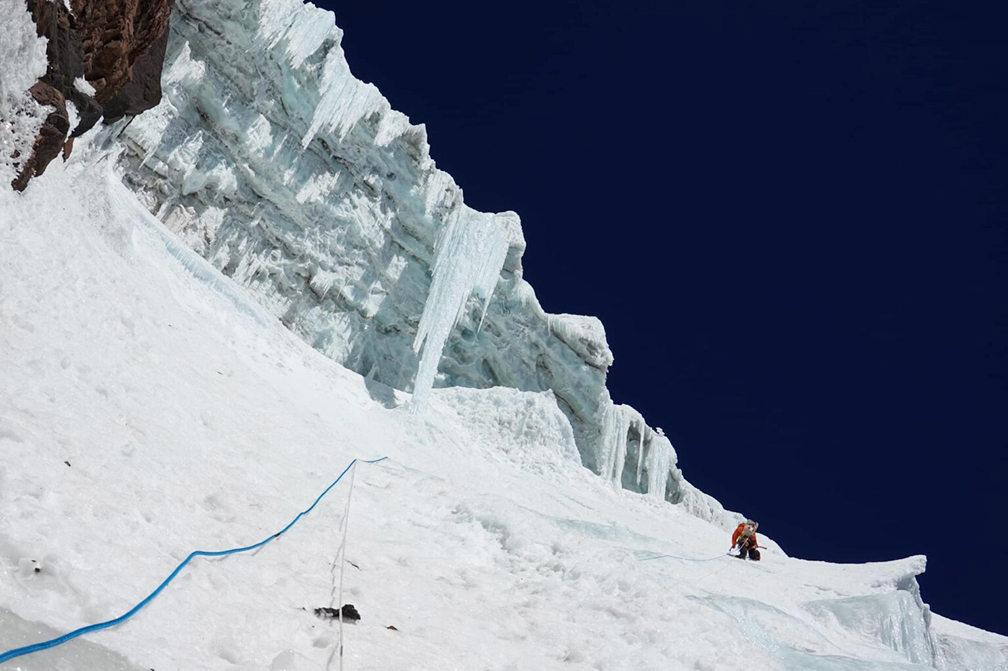
A Japanese climber on Ausangate in Peru. Photo: Yudai Suzuki
That is why he doesn’t like to fix ropes on a route. Even fixing a few pitches at the bottom of a big face reduces the level of uncertainty, commitment, and adventure.
“All on-sight from the very bottom to the summit is the ideal style for me,” he says.
Suzuki agrees with multi-Piolet d’Or winner Paul Ramsden that traversing the mountain instead of rappeling down the ascent route is more adventurous on the descent. Sometimes, however, that is not possible.
“On Thui 2, we rappelled mostly the same route as the climb up because we were very tired and the wind was so strong,” he said. “The mountain was also loaded with fresh snow, and we were concerned about the avalanche risk on the other side.”
He also noted that the descent on Thui 2 was far from easy, anyway.
“We had [to lay] solid anchors every 60m, saving gear because we still had many pitches to rappel. We also downclimbed some sections.”
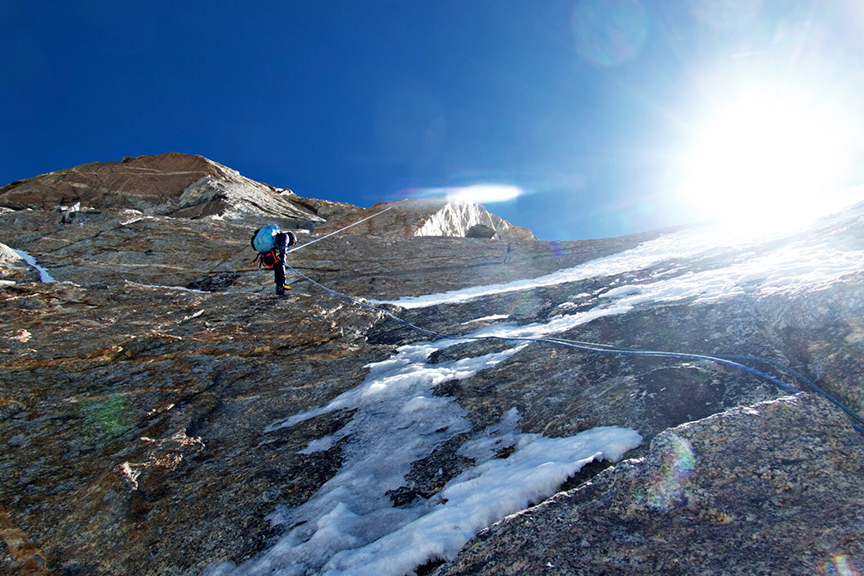
Rappeling down on Thui 2. Photo: Yudai Suzuki
“In 2023 on Ausangate and in 2024 on Quitaraju, we traversed to another face for the descent,” Suzuki said. “On both expeditions, we had earlier used the descent route for acclimatization. And yet it still felt satisfying to make a giant loop around these big mountains.”
The technical and the aesthetic
The technical and aesthetic features of his chosen mountains particularly compel Suzuki.
“I like cool-looking mountains,” he says, adding that he also seeks out difficult lines.
“Modern climbing skills and new equipment make it easier to move in straightforward terrain than it used to be,” he says. “So I always want to try faces where I am sure to find tough routes that involve many types of climbing — ice, mixed, rock, snow, dry tooling, and free climbing.”
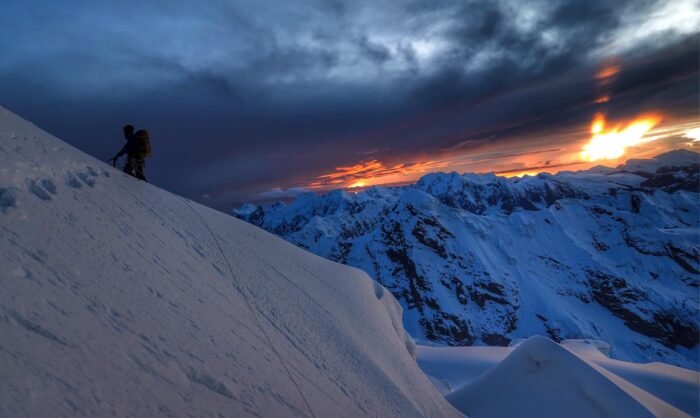
Isolation is a bonus for Yudai Suzuki when selecting a goal. Photo: Yudai Suzuki
He is also attracted to long routes. “There are many one- to six-pitch routes in Japan, so when I go abroad, I look for faces that are at least 1,000m long,” he notes.
Last but not least, location matters: “Remote areas are always more fun than well-known places,” he explains. “For instance, many mountains in Nepal require a four- to five-day trek. But [while] there are no roads, you can order pasta and curry, have WiFi, and take a shower at a nearby village. There is also a lot of info about the area.”
Pakistan, on the other hand, and especially the Hindu Raj, is more mysterious.
“You don’t know what lies ahead until you actually get there, even if your targeted peak is only one day away from a trail,” he says.
Such off-the-beaten-track places are also less expensive than popular mountain hubs — something that Suzuki, who is usually on a tight budget, considers.
Suzuki’s expeditions in the Hindu Raj didn’t even have a cook at Base Camp. That reduced the overall cost but also gave the team a sense of independence.
“We ate exactly the quantity and type of food that we wanted to eat,” he said.
In Pakistan
While he climbs with different partners, Suzuki has found regular teammates in Kei Narita and Juu Nishida.
“Kei Narita and I have been climbing together since 2020,” Suzuki says. “We met in Hokkaido when he was still a college student, and he had many days off. That was great with me since I had to work most weekends, and I needed a partner on weekdays.
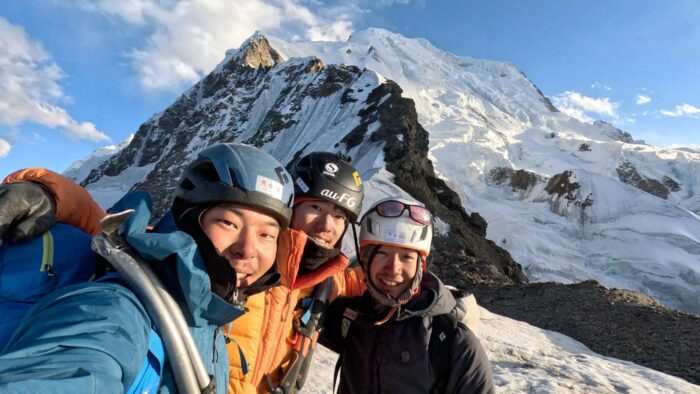
Left to right, Narita, Suzuki, and Nishida on Ghamobar Zom 5. Photo: Kei Narita
“But most importantly, we had the same motivation and similar criteria for our favorite climbs. We climbed lots of ice and difficult mixed climbs in Hokkaido and then climbed Ausangate and Ghamubar Zom 5 in 2023 and Thui 2 in 2024.”
Suzuki started climbing with Juu Nishida, who belonged to another university mountain club, in 2022 when they paired up on Alaska’s Mount Hunter.
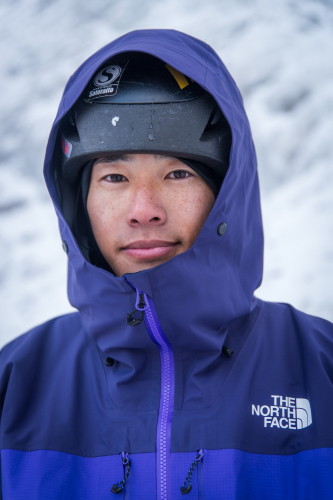
Yudai Suzuki. Photo: The North Face
Risk in the 21st century
We asked Suzuki about the tragic accident that took the lives of Kazuya Hiraide and Kenro Nakajima on the West Face of K2.
“I think Hiraide and Nakajima’s line was relatively risky but also beautiful,” Suzuki said. “They were very confident about climbing fast at high altitudes. I am not super-strong at altitude, so I choose lines that may be steeper but safer. Thui 2 was a good example: That face was very steep, long, and technical, but it was kind of safe from serac fall and other hazards. In general, I always try to reduce the uncontrollable risks, such as seracs and loose rocks.”

Kei Narita tackles thin ice and does some difficult crack climbing on Thui 2 in Pakistan. Photo: Yudai Suzuki
He admits there are not that many alpine climbers in the Himalaya. “It requires high skills and experience, both mentally and physically,” plus a lot of preparation.
“Yet I hope wider audiences may come to understand the beauty of alpine climbing,” Suzuki said. “In Japan, many people still believe that climbing Everest by the normal route is the most difficult and notable climb in the world. That shouldn’t be the right direction to look for inspiration.”
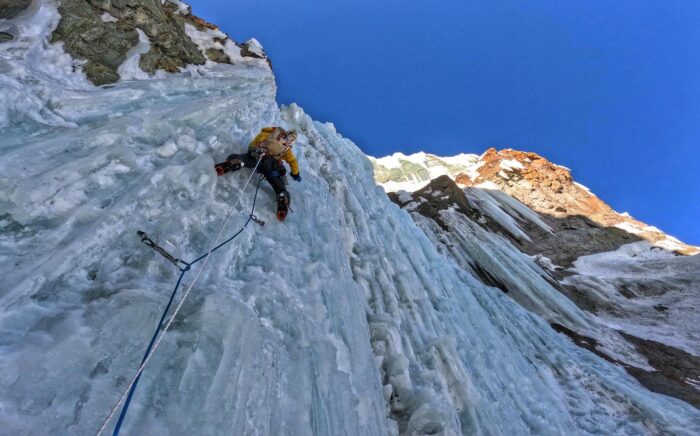
Suzuki on Ausangate. Photo: Suzuki/Facebook
A tight community
Asked about other Japanese teams currently doing interesting things, Suzuki immediately mentioned the Giri Giri boys.
“They are big in the small Japanese alpine climbing community, for sure. Almost all young and motivated Japanese alpine climbers have read their many articles about their first ascents and new routes in Alaska, Pakistan, Nepal, India, and Patagonia.”
“Yet the Japanese alpine climbing community is so small that if you climb for 10 years, you can actually make friends with them. They are really strong and so good at climbing, but they are also just ‘normal people’ — unlike a billionaire baseball player.”
